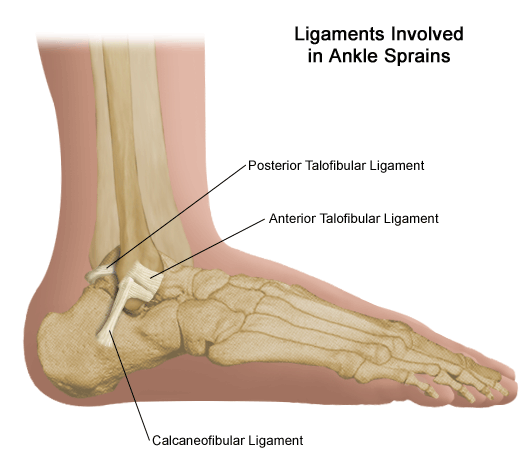The ankle facilitates up and down movement between the leg and the foot. It is a hinge joint with the bones of the leg forming a slot and the talus bone of the foot fitting between them. The bones of the leg, mainly fibula and tibia, connect with the talus and stay in place due to strong bands of tissue called ligaments. Each ligament consists of several strands or a fibrous material called collagen, which is very strong. The deltoid ligament, which is on the inside of the ankle, has a couple of layers. Although the ligament is quite strong, fractures of the anklebones can tear them apart. Sporting injuries involving ankle ligament are rare, but torn ligament in ankle is always a possibility.
Grades of Ankle Ligament Damage
 Ligament damage can be mild or severe, and is divided into different categories considering their severity.
Ligament damage can be mild or severe, and is divided into different categories considering their severity.
- Grade I: You may only have some mild damage to the fibers due to micro tearing of the ligaments.
- Grade II: This refers to partial tearing of the ligament. It may also cause abnormal laxity of the ligaments.
- Grade III: These types of injuries will cause torn ligament. This will make your ankle joint unstable.
Causes of Torn Ligament in Ankle
A torn ligament is the outcome of an ankle injury, which occurs when you twist your ankle joint a little too far out of its normal position. Walking on uneven surfaces or engaging in certain sports may result in ankle injuries. Wearing high-heeled shoes or walking in loose-fitting clogs or sandals may also contribute to ankle injuries. An ankle injury can also happen when landing awkwardly after a jump, having a sudden impact such as a car crash and twisting the ankle.
How to Treat Torn Ligament in Ankle
You can start with self-care measures, especially for minor injuries that does not involve completely torn ligament. For serious injuries, you may need surgery.
R.I.C.E.
Rest, Ice, Compression, and Elevation always help. Soon after your injury, you will fail to put any weight on your ankle. It is a good idea to take complete rest for some time.
- You should also try to have active rest and do not use pain-provoking movements. It is a good idea to wear ankle-walking boot or you can also use crutches or wear a supportive ankle brace for support.
- Applying icepack will also help reduce pain and swelling. Just make sure to apply ice for about 20 minutes every couple of hours or so. Use it when your injury is warm or hot.
- Using a compression bandage will also help. You can opt for kinesiology supportive taping because it provides support to your injured tissue and plays a role in reducing excessive swelling.
- Keep your injured ankle elevated above your heart to reduce swelling.
Physical Therapy Interventions
Physical therapy interventions are required to protect the ligament and reduce pain and swelling. Therapy will also help improve motion through strengthening, stretching, and aerobic exercises. You may require different types of therapy depending on the severity of your torn ligament in ankle.
- For Grade I-II: Physical therapy aims to protect the joint and ligament, and progresses based on your symptoms. You need therapy after the removal of immobilizing device for proper rehabilitation.
- For Grade III: These injuries usually require surgery. After the surgery, it is important to undergo physical therapy sessions to tighten up the ligament. It also helps restore motion and function depending on your doctor's post-operative protocol.
There are different methods used during physical therapy. Here are the most common physical therapy interventions used for different injuries causing torn ligament in ankle.
- Manual therapeutic technique (MTT): It involves hands-on care including deep friction massage, soft tissue massage and joint mobilization.
- Therapeutic exercises (TE): It includes different strengthening and stretching exercises to help regain full range of motion to stabilize and protect ankle.
- Neuromuscular reeducation (NMR): It involves using certain techniques to restore stability by training the lower extremity chain.
- Modalities: These interventions include use of electrical stimulation, ultrasound, ice, laser, cold and others to reduce inflammation and pain.
- Home program: It involves giving instructions to help you perform stretching, strengthening, and stabilization exercise at home to perform daily tasks with ease.
Medical Management
You should go see your doctor if you suspect you have a torn ligament in ankle. Your doctor will determine the severity of the injury and select an appropriate treatment. They will
- Evaluate it through a physical exam, MRIs, and X-rays.
- Explain how to use ice and immobilization to reduce pain and damage.
- Prescribe anti-inflammatory medication for pain relief.
- Recommend physical therapy for rehabilitation after immobilization.
- Recommend surgery for grade III injuries.
How to Prevent Ankle Ligament Damage
To reduce your risk of an ankle injury and torn ligament in ankle, you should always keep the following tips in mind:
- Do not exercise or play when you are tired.
- Maintain a well-balanced diet to keep muscles strong.
- Take steps to maintain a healthy body weight.
- Avoid falling accidents.
- Avoid ill-fitting shoes and select the right pair for right sporting activity.
- Never wear shoes with worn-out heels.
- Be active and exercise regularly.
- Be sure to warm up your body before playing a sport.
- Always run on flat surfaces.
